
What is neotango?
And if so how many?
A polemic to the relation of neotango and Retro Tango
»In the matter of tango it is always very precarius to express an opinion. The risk to claim something fallacious about the tango or to offend living or dead historical persons of the genre is immense. It´s no valid question whether Carlos Gardel is an Argentinian or Uruguayan by birth – in fact it seems natural to assume that by Gotan Project the fourth tango revolution has taken place.«
Philippe Cohen Solal, Gotan Project
The guess that Diego Siegelwachs supposed in his article of 2007 »GOTAN PROJECT and the fourth tango revolution« unmistakable has been proved to be true.
(cf. http://www.alolatino.de)

»La Revancha del Tango« of Gotan Project in 2001 marks not necessarily historically, but stylistically the birth of the neotango, to a trendy, danceable style mix of the tango with electronic beats and sounds. The neotango has lined up to burst open the congealed musical, dance-like, social and communicative conventions of the tango of the 80th and 90th. Comparable to the formation of the jazz it melts the tango with impulses of the broad range of the contemporary youth culture, revitalises itself and regains its basic liveliness, power of innovation and improvisation.
In this process it meets with disapproval by the exponents of the soi-disant »Tango Argentino « which refers his identity to the classicistic zenith of the Tango Ríoplatense, to the Tango d`Oro of the 40th. As this hegemonic, retrogressive claim demands exclusively all the form vocabulary of the tango – from dance through fashion to music – this position can be labeled as Retro Tango.
»The concept denotes a cultural phenomenon which produces pieces of art or cultural achievements in general neither based on contemporary style codes nor as their creative advancements or as original new creations, but by recourse to concepts or styles of past periods.«
(cf. http://de.wikipedia.org)
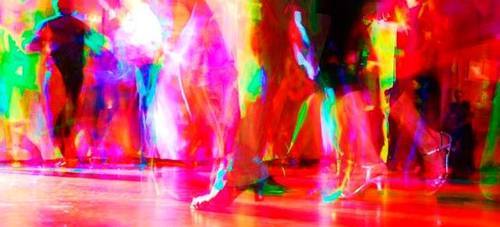
The Retro Tango assimilated to a curious position similar to an oar: You do´nt see where You are travelling to and what You see becomes more and more far off and unsharp. It indicates an aesthetic recourse to the form vocabulary of the expiring Golden Age and links it to an offensive and dogmatic claim to exclusive agency. It claims the exclusive representation of the authentic »Tango Argentino « as the final endpoint and climax of its evolution.
Did the Retro Tango claim the monopol of the whole history of the tango as a matter of fact? On the contrary the proscribed neotango established a relational link to the archaic roots of the tango and preserves it culturally from a bygone eras.
As the periods are well-konown, a shortened, highlighted review on the evolution of the tango should last out.
1. Period – Early tango history
Dance and music have been longly and inextricably linked with each other all along the history of the tango. Since it´s early beginnings it has been part and parcel of the national culture of African slaves, indigenous ehtnic groups and European immigrants. At that time the Candombe as a formerly ritual dance pantomime, the Habanera, Mazurka, Polka, Waltz and Ländler as well as the mobile instruments bandoneon, flute, violin and guitar developed quasi improvising-anarchically into its musical and dance-like basis.
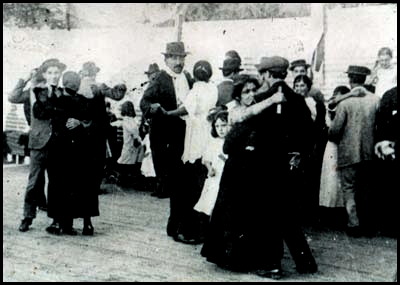
2. Period – Consolidation (1880 – 1955)
The tango left the impoverished quarters of Buenos Aires – arrabales – towards Europe, returns ennobled as the Salontango into the executive lounges of the Argentine upper class and up to the Golden Age of the 40th it undergoes a comprehensive impetus of professionalization, as well as a broad social recognition for the tango orchestras and dancers.
3. Period – Restoration (~ in 1980)
The interruption of the development dynamics in Europe and especially in Germany by the upcoming fascism in the thirties respectively by a series of military dictatorships in Argentina (1955 – 1983) forced the peculiarity of the Retro Tango. As a whole generation of tango musicians and dancers was scrapped, the tango of the 80th just linked to the endpoint of the tradition line.
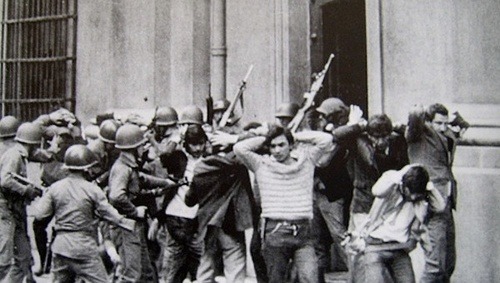
The rare exception was of the first proscribed, then world-celebrated innovator of the tango – the bandoneonist and composer Astor Piazzolla. The Horizonte Festival in the year 1982 at Berlin as well as the stage show »Tango of Argentino« in Paris released a tango wave which refused to subside until day and lresulted in the foundation of tango studios in almost every large city.
(see also: http://www.folker.de)

»The construction of the market tango in Europe began at the very moment the exiled Argentines, who immigrated to Europe in the late seventies and early eighties years in consequence of the emerging military dictatorship in their native country – started a new subsistence in the megacities of Europe. The tango became their mainstay and identification in Europe.« (cf. Vicky Kämpfe, Tango der Metropolen. Bedeutungsveränderungen des Tango auf seinem Weg von Buenos Aires in die europäischen Metropolenkulturen, S. 108). The Milongas – mostly affiliated to tango studios just as balls and festivals – were utilized as a recruiting field to interest attendees for their lucrative workshops.
The Retro Tango cultivates its exclusivity and consolidates the ware value in conjunction with tango producers and consumers. It was wrested from his social environment, was elevated, professionalized, classicistic engraved in stone and to an exclusive, expensive, perchaseable brand name which comes into play with the marketing instruments of the top management. (cf. the study of Marta Savigliano, who presents an analysis of the reception, adaptation and commercialisation of the tango from a Marxist and feminist perspective. (Savigliano: Tango and the political Economy of Passion, Boulder: Westview, 1995)
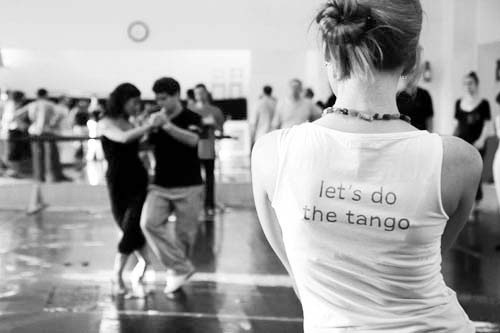
Central component of it´s commercialisation and branding was their development to the concept of »Tango Argentino« (the term is uncommon in Buenos Aires) with the claim to exclusive agency of the »authentic« tango. For the exiled Argentines the authenticity claim accruses by their nationality itself. „Argentine star dancers can claim everything in fee, because that one will get paid who is authentic, and this means, who lives in Buenos Aires, has an Italian surname and is able to move.“ (Allebrand: Von Erotik zu Aerobic, in: Tango Danza vol. 5 (H 4), p. 78)
For the German tango-teachers, who also like to participate in the lucrative business, this disqualifier poses an insoluble problem. They are relyant on appropriating an aura of authenticity by repeated study trips to the Mecca of tango, extensively attend workshops with renowned Argentine tangoteachers as well as immersion into the tango world of the capital Buenos Aires as a substitute. »The tango was rediscovered in the 80th by the Europeans in the alcove of the dark alleys of Buenos Aires.«
(http://www.ila-web.de)
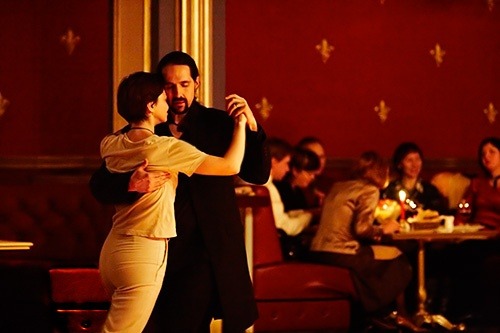
In this period a busy «exchange of goods« evolved between the tango metropolises of Europe and Argentina (as well as in Japan and the USA) which refined the tango to an import- / export-product. As a result of this process the European Tango mutated to a regressive, nostalgic reverse orientation on the »authentic tango« of the golden era 30s till the 50s of the last century. It`s more than a nostalgic trend towards the musical and dance-like roots of this period. In the broadest sense it`s a comprehensive re-enactment and idealisation of the tango inventory adapted to the benchmarks of the relatively short period of the Tango d`Oro and its rigid obsession with the classicistic solidified systematics of the Retro Tango with these components:
♦ community with distinctive internal hierarchical structures and maintenance of an elitist external appearance.
♦ musical restriction on the Sexteto Típico and the Orquesta Típica as the character defining tango formations of the tango d’‘Oro
♦ distinguished locations, like cafés, salons and glamorous ballrooms
♦ hospanic professional jargon
♦ flamboyant, expensive and conspicuous dress, shoes and accessories
♦ choreographic restoration of the traditional gender relation
♦ weird, almost courtly appearing rituals and codes
(cf. http://www.el-amateur.de)
4. Period – Innovation
Tango Nuevo (~ in 1960 / in 1990)
The boundaries between Tango Nuevo and Neotango are fluently – stylistic distinctions don`t affect the milonga everyday life, even if there are single views which frantically try to maintain the stilistic distinctions.
(cf. The difference between Nuevo and Neo:http://www.virtuar.com)
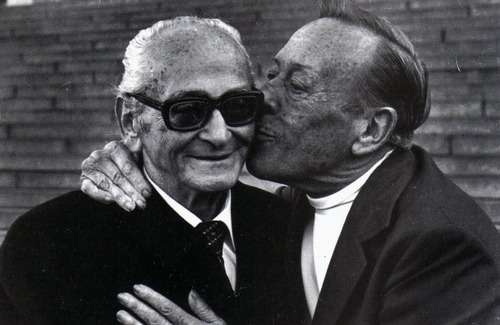
The compositional innovation of the tango in the sequel is due to Astor Piazzolla. »Piazzolla expedited the tango and assimilated extremely different influences for this purpose. Thus in the pieces of Piazzolla You can listen to elements of the Classicism as well as the Argentine folklore, the New Music and ingredients of the Jazz.«´
Since the early 90th Gustavo Naveira, Fabian Salas and Pablo Veron started to establish a new tango dance-system, which was called Tango Nuevo referring to Piazzollas improvisation technology.
4. Period Neotango (~2001)
Music
The Neotango – concerning the orchestration it is referred to as Electrotango – links to the Tango Nuevo and its roots in the Progressive Jazz, Classicism and New Music, as well as to Trip Hop, Deep House, Downbeat, Ambient and Worldmusic. The explicit reference to its African roots such as the Murga and Candombe, which are stylistically strong affected by percussion instruments outlines musical connections between the archaic commencements and contemporary style elements of the tango.
»The music style arised simultaneously in Europe and in Argentina at the end of the 90s. There were first attempts in the experimental House (Tango-House) as well as in the Trip Hop and in the Drum “n” Bass scene.«
(http://de.wikipedia.org)
As the identities, identification patterns and the cultural products of the nation states are less marked than in the past, but rather distinguished by the globalized diaspora, it is hardly noteworthy that tango and contemporary music coalesced into a unit almost at the same time in Europe (and Argentina). An endless number of neotango bands with an unlimited stylistic diversity came into the limelight: Bajofondo, Gotan Project, Narcotango, Otros Aires, Tanghetto, Ultratango, Electrocutango, Tango Crash, Tango Fusion Club, San Telmo Lounge to name just a few. The playlist of the tanguerilla, a neolonga located at Bremen, Germany actually includes more than 140 neotango interpreters. In view of this wide musical spectrum neotango don`t refer to as a niche product.
Stylistic and instrumental contrasts generate a suspense curve, neotango appears both archaically and modern, down-to-earth and rampant unleashed, intimate and exhibitionistic, cooly intellectually and erotically lascivious. Acoustic instruments were arranged with electronics, dominant bass and rhythm lines superimpose violins, sound samples, scratches and drumcomputer interlink with female solo parts and finally the bandoneon gives whole composition the unique tango appearance.
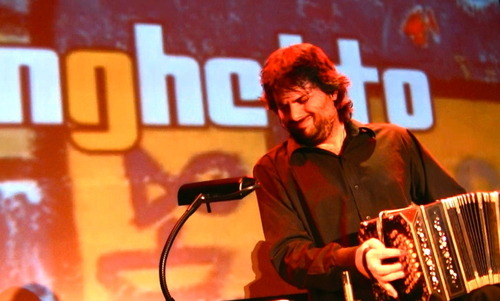
Dance
The neotango dance has its roots in the straight, accented street style of the Tango Orillero as it was danced at the end of the 19th century.
(cf. http://www.virtuar.com)
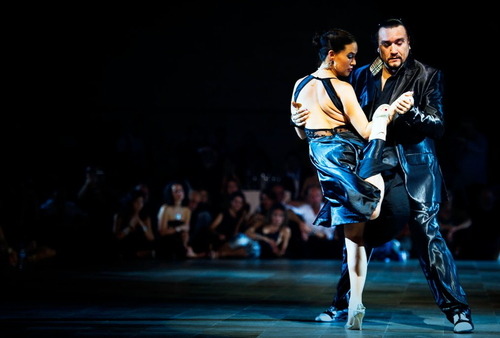
Neotango as a dance style is referred to as the deliberate opening, through to the abandonment of the classical dance position. Elements of the of movement and expression repertoire of the Contact Improvisation, the Dance Improvisation and the Modern Dance have been partly incorporated. Elements playing with the abandonment of the axis, the gravitation and centrifugal forces as well as opposite dance directions are typical. However the style is not focused on special figure sequences but on innovative movement principles and variations.
Locations
A growing number of avant-garde neotango-Locations which are called neolongas, tango clubs, tango lounges or elongas evolved off the beaten track. Actually there are 35 regular neolongas in the German-speaking realm.
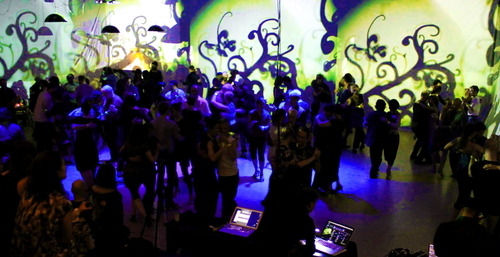
Inspired by the movie »The Tango Lesson« with Sally Potter and Pablo Verón but also for financial reasons neolongas and eLongas often take place at locations which label historically the dawn of the tango: streets, factories and backyards. Thus the neotango returns to its social starting point, the working-class neighbourhoods and public squares.
Fashion
The dresscode is informal – no special clothes are required as usually in the context of the Retro Tango. Reference point also remains the everyday culture – everything fits.
Visuals
The associative power of tango as visual music, but also the audio-visual character of milongas and concerts – where it`s usual to dance – inspired neotango bands like Gotan Project, Otros Aires, Tanghetto and San Telmo Lounge to improve their live gigs with video-shows. Aesthetically inspired by music videos, preproduced, sequential video-projections have been incorporated in some neolongas and elongas. In further-reaching concepts visuals will be produced in real-time by a VJ and broadcast live on giant screens and synchronized very precisely with the rhythm and pitch of the neotango music. Thus creates a virtual, media-generated space which merged with the seductive sensuality of the tango to a location of magical intensity.

After years of hermetic seclusion the neotango reopens an advanced perspective of the tango, which renounces discriminations, exclusions, monopolies and hegemonial claim to the benefit of a musical, dance-like, and social diversification of the tango Irrespective of sexual identities.
With the support of the neotango the tango returns to his roots and reinvents itself once again.
Published first in Tangodanza 1/09
Welcome to WordPress. This is your first post. Edit or delete it, then start writing!
